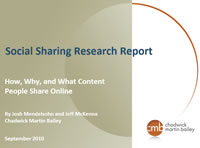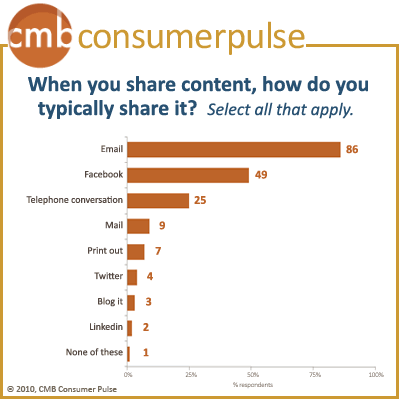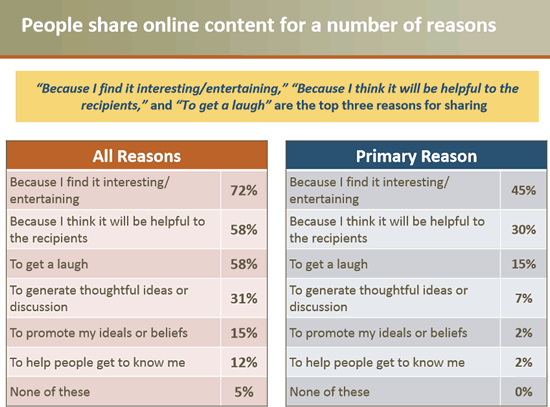
Why do people share content (or anything at all)? It’s a simple question but when looking at it, you’ll quickly discover it is all but easy, depends on many factors and requires a good deal of psychological insights. However, in trying to answering it, one can find a lot of value for his business and “target groups”. There is no universal answer. As always, it depends. But there surely are commonalities in what triggers people in content sharing.
Content is an enormously broad concept that we use every day without really defining it. We talk about how it should be: how important relevant and share-worthy content is, how crucial it is in lead nurturing, how it makes or breaks our email marketing programs and even how it has become social currency. We seldom talk about what it really is and even less about what exactly that new umbrella term, content marketing, stands for. One thing is sure: content marketing doesn’t equal marketing content.
[the_ad id=”27933″]What is even debated less is the complexity of what makes it get shared. Indeed, complexity. Human behavior is complex. And at the same time the ingredients of content sharing are simple: people forward, retweet, like or bookmark content because they want to. Because they like to share. Because they think the content deserves it. Not as such but in the relationships with the people they share it with. Does this mean we have no influence whatsoever in what people share? Of course we have. Much more than you think (and depending on the channels as well). But every time it starts with this: relevance and context.
The focus on content relevance is normal. It has a lot to do with the increasing attention for the informative needs of the customer in a two-way world where he/she searches the content that he/she needs at that time. But – let’s be honest – we especially want to know why sharing of content happens because everyone dreams of their content being “tweeted” massively, appearing on social media bookmarking sites thousands of times and getting shared via all possible channels with viral options, including obviously email. The focus on content relevance is also a must: if it ain’t contextually relevant, don’t do it.
Content sharing is a matter of channels too. In a study, Chadwick Martin Bailey and iModerate Research Technologies established email is still used most for sharing content. These are findings that do not really surprise me. However, although email is used by 86% of the respondents for sharing content, Facebook is scoring 49%, the same study found.

The types of content that get shared most
The report also provides some interesting findings concerning the reasons why email is used so often to share content: it offers a possibility of saving and sorting content, as opposed to the more real-time nature of social networks such as Twitter.
From the user viewpoint this is a valid argument, for businesses and especially SEO it is not. Obviously one can say that social bookmarking also allows you to save and sort content, but let’s be honest: social bookmarking is used more for SEO than for “sharing” and the community-aspect of social bookmarking is quite low, depending on the used service.
The report also gives some tips and facts concerning the type of content that people share most and also how important it is to make your content share-worthy.
In decreasing order of importance, Chadwick Martin Bailey and iModerate Research Technologies found, people mostly share news about:
- a family member or friends (81%)
- family pictures or video (80%)
- funny videos (63%)
- coupons/discount (54%)
- news articles and blog posts (53%).
Based on this list, it is clear that personal and plain fun content are shared most, probably another argument for word-of-mouth marketing. From the business perspective, promotions and information score well. It’s also clear that consumers want compelling and relevant promotions and that there are several reasons to focus more on content marketing in general and blog marketing specifically.
But what about all other forms of content that fit more in the interactions between business and businesses or businesses and “consumers”? Online presentations, customer cases, referrals and testimonials and the gazillion of other content formats and elements?
The many dimensions of content in context
Very few studies answer why people exactly share content but even less look at why people share one type of content more than the other or how they share different sorts of content per sharing medium or channel.
I do not think that one can answer the content sharing question by only looking at the content itself.
Obviously, for example, a blog post with a spectacular headline will be “re-tweeted” easier and it is clear that a well written piece from the usability and even SEO perspective will be shared more (because people read and find it respectively). Easy and short often work good too but don’t let that come in the way of what you stand for. In the end, maybe that matters most of all for your business and customers too. Unless your metric is “being shared as much as possible”, period (don’t laugh, it happens all the time).
But apart from the quality of the content the answer should be searched for somewhere else more: in the context of the content. That context is function of the psychological promise, fulfilment, experience, perception, ‘consumption’ environment, device, intent, emotional state, requirement etc. of the person that comes into contact with the content, irrespective of the channel and the format (an informative blog post, an ad, an online video, a press release, a white paper etc.).
It is probably not a world shocking finding and should definitely be further worked out (there is for example also an important dimension of “timing” and even “coincidence” and “design”) but it becomes time that we look further than the content itself and evaluate the context much more, something that is not done often enough today.
Dynamics of the act of content sharing
Sharing is an activity that occurs in a short time span and that assumes a “trigger” to share. It is like clicking a link: a quick action that happens in an impulse, although clicking sometimes is “easier and faster” than sharing (but then again, tweeting or retweeting is simply clicking a button as well).
The triggers are very personal, subjective and relative. Thus context. In general one could say there are two kinds of triggers to share content:
- The rational trigger of content sharing: content gets shared because it is rationally deemed valuable and relevant to do so.
- The emotional trigger of content sharing: content gets shared because it’s fun or emotionally appealing and because sharing it fulfils an emotional need or desire.
But both overlap and from a psychological perspective what we call ‘rational’ is often really ‘emotional’. Moreover, in this easy model, many elements are missing: the timing-determined pertinence, the placement of sharing tools, the channels and how they are combined, coincidence (to share something you have to “see” it pass in the social sphere) and even the different characteristics of various types and formats of both content and sharing channels. Finally, let’s not forget the dynamics of cross-channel sharing and spreading, and how sharing virally works after a specific piece of content has been shared a first time, as well as the different types of what we often call influencers, in this case “people that share and get shared”.
In the mentioned study, respondents were asked why they share content. But, knowing the highly emotional and impulsive nature of sharing as an act, that could be an a posteriori explanation in many case. People share because it will benefit them, whatever possible (including emotional and unconscious) way. But let’s see what they answered.

An interesting puzzle for a matrix that answers the question why and when which people share what type of content over what channels. A challenge for which your input is welcome.
In the mean time one thing is sure: people share content if they want to and if it doesn’t take too much effort doing it…
Ask yourself: do we share content or do we share experiences and stories with the sole purpose of emotional gratification?

